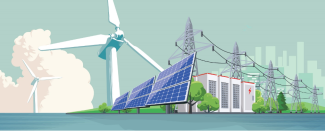In the global struggle to combat and adapt to climate change, the impact of the energy sector is impossible to overlook. Energy production accounts for more than two thirds of global greenhouse gas emissions, and coal-fired power plants were the single largest contributor to the growth in emissions observed in 2018, exceeding 10 Gigatons for the first time in history. Nearly every aspect of our electrical infrastructure affects the environment, whether through greenhouse gas emissions, resource use, or the generation of waste.
In 2018, 65 percent of the United States’ electricity generation was produced from fossil fuels. As a result, electricity generation accounted for 26.9% of the country's total greenhouse gas emissions. But less well known is the sector’s reliance on water. Most thermal plants rely on water to cool high temperatures and steam-power turbines, consuming and polluting water that then requires extensive cleaning to become reusable.
Additionally, certain electricity generation methods produce solid and sometimes hazardous waste. Some of this is disposed of in landfills, while toxic elements require special handling, treatment and disposal. Both coal-fired and biomass generation produce fly ash with varying degrees of toxins, and nuclear waste can never be recycled. These more hazardous methods present health risks for local communities and the environment at large.
The need for metrics
To monitor, assess, and reduce these environmental impacts, end users need effective metrics to evaluate and understand their current infrastructure and work toward more efficient solutions. An environmental impact assessment take three key pillars into consideration:
- Air quality (carbon dioxide, nitrous oxide and sulphur dioxide emissions)
- Water usage
- Solid waste generation
Source energy intensity (SEI) is another important metric to measure the energy efficiency of gross electricity supplied by determining the amount of non-renewable energy required to deliver one unit of electricity.
By combining all these metrics, the PEER (Performance Excellence in Electricity Renewal) rating system has developed the Energy Efficiency and Environmental (EE) Index, which helps end users – from utilities and campuses, to communities and cities – to evaluate the their environmental impact and work toward a more sustainable model.

PEER’s Energy Efficiency and Environmental Index
PEER is the world’s first certification program advancing sustainable, resilient and reliable energy through the measurement and improvement of power system performance. The PEER rating system’s Energy Efficiency and Environment credit category provides an assessment of the “contracted electricity”: a nutrition label of sorts that identifies the “health” of the electricity that feeds a project site. It includes the EE Index metric, which is a comparative environmental performance assessment for the electricity that is supplied or generated from the source to the site after considering the Transmission and Distribution (T&D) losses.
The EE Index helps projects to monitor the environmental consequences of energy generation, transmission and distribution by evaluating the project’s source energy, air emissions, water use and solid waste performance.
With the EE Index, power distribution utilities are provided with a framework to:
- measure their environmental performance,
- distinguish themselves from other utilities,
- get better negotiation on procurement contracts, and
- benchmark themselves with their State/Country benchmark value.
Through benchmarking on the EE Index, cities, communities and end-users now have a more streamlined way to work toward their sustainability agenda. This Energy Efficiency and Environment category of PEER also provides strategies that encourage the adoption of clean and efficient energy through these similar categories.
Through steady global adoption, this methodology is creating a competitive market for energy efficiency and environmental performance improvement – starting with investments in renewable energy technology, microgrids and smart grids, and other innovative approaches to low-carbon, highly efficient electricity generation.
Learn more about PEER and EE Index through the PEER Education Course 101, Course 102 and PEER v2 Rating System.
